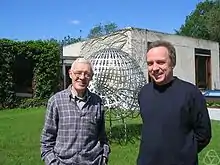Robert Moody
Robert Vaughan Moody, OC FRSC (/ˈmuːdi/; born November 28, 1941) is a Canadian mathematician. He is the co-discover of Kac–Moody algebra,[1] a Lie algebra, usually infinite-dimensional, that can be defined through a generalized root system.
Robert Moody | |
|---|---|
 Robert Moody (left) | |
| Born | November 28, 1941 |
| Nationality | Canadian |
| Alma mater | University of Toronto |
| Awards | Coxeter–James Prize (1978) Jeffery–Williams Prize (1995) Wigner Medal (1996) CRM-Fields-PIMS prize (1998) |
| Scientific career | |
| Fields | Mathematics |
| Institutions | University of Saskatchewan University of Alberta |
| Doctoral advisor | Maria Wonenburger |
"Almost simultaneously in 1967, Victor Kac in the USSR and Robert Moody in Canada developed what was to become Kac–Moody algebra. Kac and Moody noticed that if Wilhelm Killing's conditions were relaxed, it was still possible to associate to the Cartan matrix a Lie algebra which, necessarily, would be infinite dimensional." - A. J. Coleman[2]
Born in Great Britain, he received a Bachelor of Arts in Mathematics in 1962 from the University of Saskatchewan, a Master of Arts in Mathematics in 1964 from the University of Toronto, and a Ph.D. in Mathematics in 1966 from the University of Toronto.
In 1966, he joined the Department of Mathematics as an assistant professor in the University of Saskatchewan. In 1970, he was appointed an associate professor and a professor in 1976. In 1989, he joined the University of Alberta as a professor in the Department of Mathematics.
In 1999, he was made an Officer of the Order of Canada.[3] In 1980, he was made a fellow of the Royal Society of Canada. In 1996 Moody and Kac were co-winners of the Wigner Medal.[4]
Selected works
- "Lie algebras associated with generalized Cartan matrices". Bull. Amer. Math. Soc. 73 (2): 217–222. 1967. doi:10.1090/s0002-9904-1967-11688-4. MR 0207783.
- "Macdonald identities and Euclidean Lie algebras". Proc. Amer. Math. Soc. 48 (1): 43–52. 1975. doi:10.1090/s0002-9939-1975-0442048-2. MR 0442048.
- with S. Berman: "Lie algebra multiplicities". Proc. Amer. Math. Soc. 76 (2): 223–228. 1979. doi:10.1090/s0002-9939-1979-0537078-x. MR 0537078.
- with J. Patera: "Fast recursion formula for weight multiplicities". Bull. Amer. Math. Soc. (N.S.). 7 (1): 237–242. 1982. doi:10.1090/s0273-0979-1982-15021-2. MR 0656202.
- with Bremner & Patera: Tables of weight space multiplicities, Marcel Dekker 1983
- with A. Pianzola: "On infinite root systems". Trans. Amer. Math. Soc. 315 (2): 661–696. 1989. doi:10.1090/s0002-9947-1989-0964901-8. MR 0964901.
- with S. Kass, J. Patera, & R. Slansky: Affine Lie Algebras, weight multiplicities and branching rules, 2 vols., University of California Press 1991 vol. 1 books.google
- with Pianzola: Lie algebras with triangular decompositions, Canadian Mathematical Society Series, John Wiley 1995[5]
- with Baake & Grimm: Die verborgene Ordnung der Quasikristalle, Spektrum, Feb. 2002; What is Aperiodic Order?, Eng. trans. on arxiv.org
Notes
- Stephen Berman, Karen Parshall Victor Kac and Robert Moody — their paths to Kac–Moody-Algebras, Mathematical Intelligencer, 2002, Nr.1
- Coleman, A. John, "The Greatest Mathematical Paper of All Time," The Mathematical Intelligencer, vol. 11, no. 3, pp. 29–38.
- "Robert V. Moody Appointed Officer of the Order of Canada" (PDF). Newsletter of the Pacific Institute for the Mathematical Sciences. 4 (1). Winter 2000. p. 1.
- Jackson, Allyn (Dec 1995). "Kac and Moody Receive Wigner Medal" (PDF). Notices of the AMS. 42 (12): 1543–1544.
- Seligman, George B. (1996). "Review: Lie algebras with triangular decompositions, by Robert B. Moody and Arturo Pianzola" (PDF). Bull. Amer. Math. Soc. (N.S.). 33 (3): 347–349. doi:10.1090/s0273-0979-96-00653-2.
References
- Robert Moody at the Mathematics Genealogy Project
- "Robert Vaughan Moody's Home Page".
- "Robert Vaughan Moody Curriculum Vitae". Retrieved March 7, 2006.